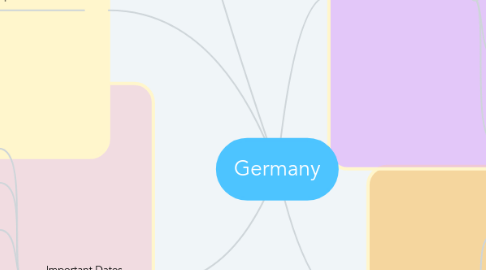Germany
by Edward Tu

1. Important Dates
1.1. 1782: first German spinning machines were built in Chemnitz
1.2. 1784: first German textile factory was built
1.3. End of 18th century: first coke-driven blast furnace built in Gleiwitz
1.4. after 1800s: Industrialization in Germany truly began
1.5. 1834: trade barriers between German states abolished
1.6. 1873: ironworks begin in Neunkirchen und Burbach and Volklingen
1.7. End of 19th century: German businesses take over a leading role in chemical and electrical engineering
2. Compared to Britain
2.1. Simalarities:
2.1.1. large and abundant coal supplies
2.1.2. textile's and the machines used to weave were both products produced by the countries
2.1.3. built factories near rivers as a power supply and for maintenance
2.2. Differences
2.2.1. not an island, but had access to the ocean in the north
2.2.2. surrounded by countries, had the option of trading by land and by waterways
2.2.3. the country was broken up into multiple states that had trade barriers in past
3. Trade
3.1. Capital from Belgium and Britain allowed for the massive expansion of various coal and ironwork towns.
3.2. The German Customs Union tore down the barriers between German states and allowed for more trade within the country.
4. Geography
4.1. The River Ruhr allowed for factories to be built close to a power supply.
4.2. Germany's neighboring countries include Belgium, France, Czech Republic, Poland, Denmark, Austria, and Liechtenstein.
4.3. The land was mostly used for farming and was rural before factories and industry started to pop up.
4.4. Has access to the ocean in the north and is surrounded by other countries on all other sides.
5. Resources/Products
5.1. There was an abundance of coal located in multiple areas. Coal mining in villages like Ruhrgebiet were quickly growing. Essen had capitalized on rich coal supplies and became a industrial center due to their deep mines.
5.2. Steel was quickly growing in demand as railways were being built continuously. The Hoesch firm was a large company that became one of the key figures in Germany's steel industry.
5.3. Silver mining was being aided by a new invention, the steam engine. The silver was used by aristocrats to expand their wealth.
5.4. Textiles were made using spinning machines. These were generally located in already established trading centers like Aachen, Krefeld, and Saxony. There was both thread and silk being spun


